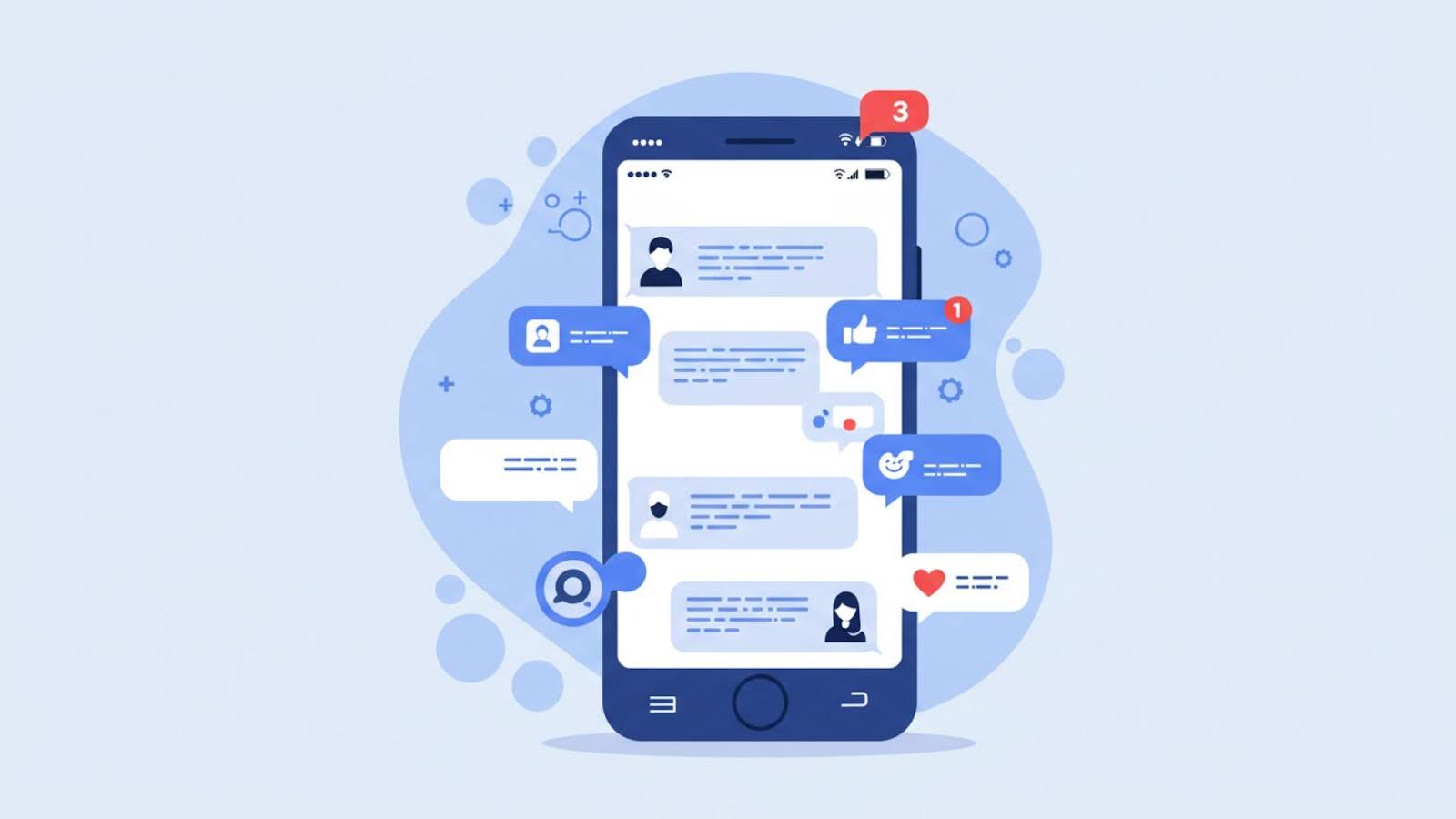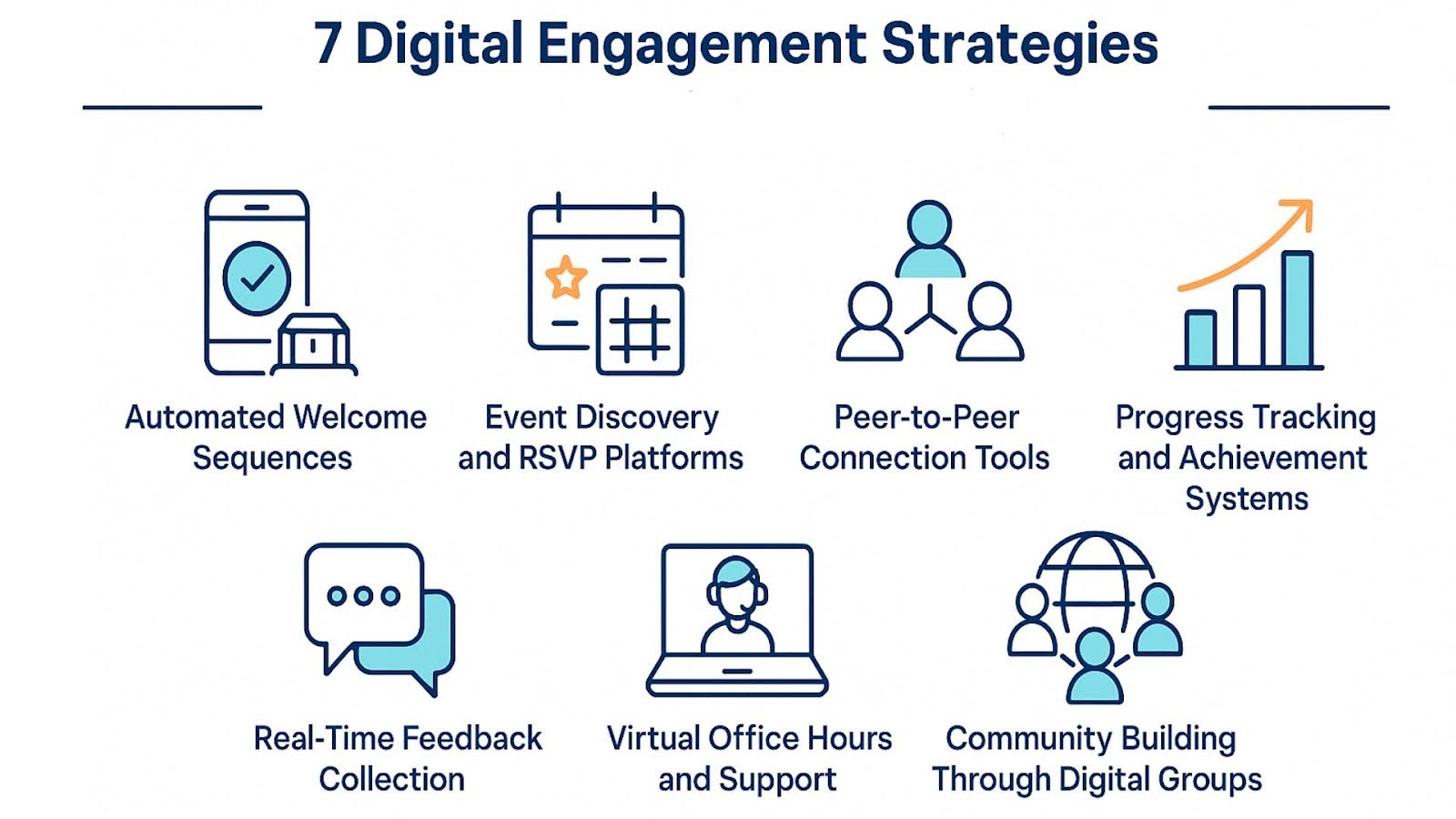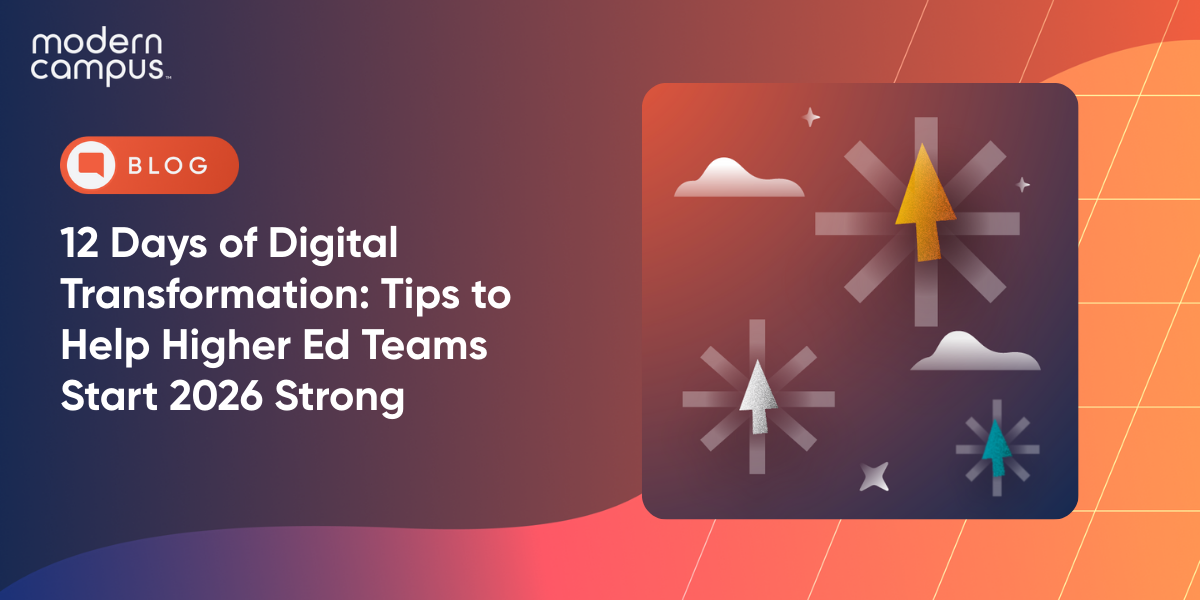How to Enhance Student Engagement with Technology
Digital technology transforms student engagement through personalized, accessible experiences that meet modern learners where they are.
- SMS texting achieves 98% open rates vs 20% for email, making it the most effective communication channel
- Gamification increases academic performance and shows student preference over traditional courses
- Mobile-first platforms boost participation rates compared to traditional methods
Highly engaged students show higher retention rates than their unengaged peers.
The digital revolution has changed how students learn, communicate and engage with their educational institutions. Yet many colleges and universities are still relying on outdated methods that fail to capture the attention of today's learners. If your institution is struggling with student engagement, you don't have to stay stuck in the past.
Technology offers powerful solutions that can transform how you connect with students, boost participation and drive real results. From SMS texting that gets read within minutes to gamification strategies that make learning addictive, the right digital tools can turn passive students into active participants who feel genuinely connected to your institution.
Why Are Traditional Student Engagement Methods Failing Modern Learners?
Today's students live in a digital-first world where they expect instant, personalized and interactive experiences. They've grown up with smartphones, social media and everything on-demand. When institutions rely solely on traditional methods like email announcements, static websites and one-size-fits-all programming, they're essentially speaking a foreign language.
The average college student checks their phone 150 times per day. Meanwhile, email open rates in various industries hover around 20%, and many students report feeling disconnected from their campus community despite being surrounded by thousands of peers.
The attention economy is fierce. Students are constantly bombarded with notifications, social media updates and entertainment options that are designed to be engaging and addictive. Traditional campus communication methods can't compete with platforms that use sophisticated algorithms and behavioral psychology to capture and hold attention.
Additionally, remote and hybrid learning has created new challenges for maintaining student engagement. When physical presence no longer guarantees participation, institutions need digital engagement strategies that work across all learning modalities.
The Digital Engagement Revolution: What Today's Students Actually Want
Understanding what drives engagement starts with recognizing that today's students are diverse in their backgrounds, learning preferences, life circumstances, and technological expectations. This fact is especially true for non-traditional students, including working adults, parents and career changers who are seeking flexible educational opportunities.
Research shows that 22% of adult learners prefer certificate options rather than degree programs. These students need engagement platforms that accommodate their complex schedules and varied access to technology. They want learning experiences that feel relevant, accessible and immediately applicable to their goals.
Modern learners expect three key things from their digital interactions:
Personalization at scale: Communications and content should feel tailored to specific interests, academic progress and career goals.
Real-time responsiveness: Whether asking questions, seeking support or trying to connect with peers, learners expect quick responses and immediate access to information.
Mobile-first design: Since most information access happens primarily through smartphones, every digital touchpoint needs to work seamlessly on mobile devices.
Recognizing these expectations helps you build an entire digital engagement strategy around meeting students where they are, not where institutions wish they were.
Why Is SMS Texting the Most Effective Engagement Tool?
While email continues to decline in effectiveness, SMS texting has emerged as the most powerful communication channel in higher education. The statistics are remarkable: 98% of text messages are opened and read, with 82% being read within just five minutes of delivery.

But the real magic happens when institutions create genuine two-way conversations. Text messaging enables the kind of immediate, personal interaction that builds relationships and trust. Students feel heard when they can ask questions and get quick responses, whether they're wondering about registration deadlines, need support navigating campus resources or want to connect with study groups.
Effective texting programs segment audiences based on factors like class year, academic program, housing status and engagement level. This classification allows for highly targeted messaging that feels relevant rather than spammy.
Smart institutions are also using SMS to guide students through critical transition points. Welcome sequences help new students navigate their first weeks on campus, while automated reminders ensure important deadlines don't get missed in the chaos of student life.
Austin Community College District increased persistence among part-time students by 15% simply by texting students reminders about financial aid deadlines and academic support resources, proving that strategic communication can drive real results.
How Does Gamification Turn Learning into an Engaging Experience?
Gamification is one of the most exciting frontiers in digital engagement strategies. By incorporating game design elements like points, badges, leaderboards and challenges into educational experiences, institutions can tap into the same psychological drivers that make video games so compelling.
Gamified learning environments can improve student performance by nearly 90% compared to traditional lecture-based approaches. Even more encouraging, 67% of students prefer gamified learning experiences over conventional courses.

What makes gamification so effective? It addresses fundamental human needs for autonomy, competence and connection. When students can see their progress visualized through levels or points, they experience a sense of accomplishment that motivates continued engagement. Leaderboards and team challenges foster healthy competition and peer connection.
The most effective implementations align game mechanics with genuine learning outcomes. For example, students might earn badges for mastering specific skills, completing community service hours or participating in leadership development programs.
The key is ensuring that game elements enhance rather than distract from educational goals. When done well, gamification makes challenging material more approachable and creates positive associations with learning that extend far beyond the immediate experience.
How Do Mobile Apps and Digital Platforms Meet Students Where They Live?
Campus mobile apps have evolved from simple directory tools to comprehensive engagement platforms that connect students to every aspect of their educational experience. The most effective apps serve as digital command centers where students can access everything from course schedules and dining menus to event listings and support services.
Functionality alone isn't enough. Successful engagement platforms prioritize user experience design that feels intuitive and enjoyable to navigate. Students should be able to accomplish common tasks with just a few taps, whether they're checking their grades, finding study spaces or joining campus organizations.
Mobile engagement provides personalized recommendations and proactive support. By analyzing usage patterns and preferences, these systems can suggest relevant events, connect students with similar interests and identify when someone might need additional support.
Push notifications, when used strategically, can be powerful engagement tools. Rather than overwhelming students with constant alerts, effective platforms send targeted notifications about opportunities that align with individual interests and goals.
Integration capabilities create seamless experiences. Students don't want to juggle multiple apps and platforms for different aspects of campus life. The best engagement platforms connect with existing systems to provide unified access to academic, social and support resources.
What Are the 7 Digital Engagement Strategies Every Campus Should Implement?

1. Automated Welcome Sequences for New Students
Create multi-touch campaigns that guide new students through their first weeks on campus. Use a combination of SMS, email and app notifications to provide just-in-time information about orientation events, academic resources and social opportunities.
2. Event Discovery and RSVP Platforms
Make it easy for students to find and attend campus events through searchable directories with filters for interests, time availability and location preferences. Include social features that let students see which friends are attending.
3. Peer-to-Peer Connection Tools
Facilitate organic relationship building through study group matching, roommate finding services and interest-based community formation. The goal is to help students find their people more quickly and easily.
4. Progress Tracking and Achievement Systems
Visualize student progress toward academic and co-curricular goals through dashboards that celebrate milestones and encourage continued engagement. Include both individual achievements and community challenges.
5. Real-Time Feedback Collection
Implement quick pulse surveys and feedback tools that let students share their experiences while they're fresh. Use this data to make rapid improvements to programs and services.
6. Virtual Office Hours and Support
Offer multiple channels for students to access support, including chat functions, video calls and AI-powered chatbots that can handle common questions 24/7.
7. Community Building Through Digital Groups
Create online spaces where students can connect around shared interests, academic programs or life experiences. These communities should extend beyond campus boundaries to support lifelong learning and networking.
How Do You Measure Success in Digital Engagement?
The power of digital engagement tools lies within the rich data they generate about student behavior, preferences and needs. This information proves invaluable for continuously improving your engagement strategy and demonstrating return on investment to institutional leadership.
Essential metrics include engagement rates across different channels, event attendance patterns, student satisfaction scores and academic outcomes correlated with engagement levels. Engaged students have higher retention rates, with some institutions seeing 13 percentage point differences between highly engaged and unengaged students.
Advanced analytics can also help identify at-risk students before problems become crises. By analyzing patterns in communication response rates, app usage and event attendance, institutions can implement early intervention strategies that keep students on track for success.
When you understand what resonates with different student populations, you can tailor your approach to maximize impact.
How Do You Overcome Implementation Challenges and Get Buy-In?
Rolling out new digital engagement strategies often garners resistance from faculty comfortable with traditional methods, students skeptical of new platforms and administrators concerned about costs and complexity.
Start small and demonstrate value quickly. Choose one or two high-impact strategies rather than attempting wholesale transformation overnight. Focus on solving genuine pain points that students and staff already recognize.
Training and support are essential. Faculty and staff need to understand not just how to use new tools but why they benefit student success. Students, meanwhile, need to see immediate value from engagement platforms or they'll quickly abandon them.
Budget concerns have merit, but the cost of poor student engagement in terms of retention, satisfaction and long-term alumni relationships far exceeds investment in effective digital tools. Many institutions find that engagement platforms pay for themselves through improved student retention alone.
Change management requires patience and persistence. New behaviors take time to become habits, but institutions that commit to the process see transformational results in student satisfaction and success.
Frequently Asked Questions
What's the ROI of digital engagement tools? Digital engagement platforms are often worth it when you see improved student retention rates. Highly engaged students have better retention rates than their unengaged peers, which translates to significant revenue increases when you factor in tuition, fees and reduced recruitment costs.
How do you ensure student privacy with engagement platforms? Reputable engagement platforms are built with privacy by design, including FERPA compliance, data encryption and granular permission controls. Students should always have control over their data and communication preferences, with clear opt-in and opt-out processes.
Which digital tools have the highest adoption rates? SMS texting and mobile apps tend to have the highest adoption rates because they align with how students already communicate and access information. Gamification elements also see strong engagement when properly implemented with clear value propositions and meaningful rewards.
Create Digital Experiences to Engage Today's Learners
Student engagement is essential for institutional success in higher education. The digital tools and strategies outlined in this guide can help meet modern learners' expectations and needs.
Whether you're looking to boost retention, improve student satisfaction or create more vibrant campus communities, technology offers proven solutions that deliver measurable results. The key is choosing tools that work together seamlessly and align with your institution's unique goals and student populations.
Modern Campus empowers 1,700+ higher education institutions to attract, engage and retain learners for life with software solutions that enable truly modern student experiences. From SMS messaging and gamified engagement to comprehensive analytics and personalized learning pathways, we provide the integrated platform you need to connect with today's learners.
Schedule a demo to discover how Modern Campus can help your institution create the engaging, technology-driven experiences that today's students expect and deserve.
Last updated: September 10, 2025



